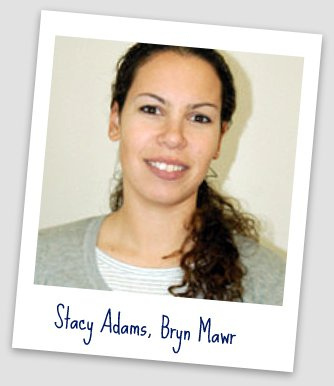The new assistant athletic director wants to help Bryn Mawr students to get and stay fit
By Sarah Fischer
As visitors and students alike ooh and ah over the new renovations of the Schwartz Gymnasium at Bryn Mawr College, Stacy Adams sits in her office and smiles over the completed job — before getting back to work.
As the Assistant Athletic Director, Adams spends all her time in the clean, naturally lit gymnasium doing paperwork, teaching classes, or helping students train for their sports season.
Her office looks out onto cardio equipment and the women of Bryn Mawr College huffing and puffing with confidence. But these women can also peer into Adam’s workspace: bare and littered with papers. Behind her desk there is mini refrigerator with a jar of peanut butter and a bag of carrots sitting on top. No candy or Easy Mac in sight.
Adams is definitely a woman you would want on your side in a fight. Tall and built, her curly hair is usually tied behind her head in ponytail. Athletic clothes are her work attire.
She is what you would call a heavyweight. Pun intended.
Adams has coached at Drexel University, West Virginia University, University of Miami, and Villanova University, just to name a few. She has worked with six year-olds as well as NBA and NFL players.
Although Bryn Mawr College, a Division III, liberal arts, all-women’s college in the suburb of Philadelphia, is definitely a contrast from those larger schools, Adams says her position at Bryn Mawr is her favorite job so far.
Even though Adams does a considerate amount of administrative work such as designing the new gym layout and working game day operations, she enjoys her interactions with students and teams.
“[The students] have such different personalities. There are some characters,” she says with a smile, “but there are some really great people from all over the world”
And this is coming from a woman that used to train NBA and NFL stars.
‘Female friendly gym’
Adams herself came to Bryn Mawr with a very different college experience. Originally from upstate New York, Adams received a scholarship to West Virginia University (which enrolls an average of 29,000 students, opposed to Bryn Mawr’s 1,300) for soccer. She graduated from WVU in 1999 with a major in Sociology and a minor in Political Science.
At Bryn Mawr College, Adams has helped to construct “a state of the art facility to help women.” She says that the new Schwartz Gymnasium is a “female friendly gym” where women are “excited to come in and learn in things…the environment is such that it doesn’t feel intimidating.”
Adams says that in terms of body image and fitness, Bryn Mawr College students are very typical. Adams sees “different levels [of people] everywhere you go. People either wanting to be fit or healthy or people exercising for sport or people not coming at all…the mix isn’t just relative to Bryn Mawr, it’s what’s everywhere”
Regardless if someone is in the gym or not, Adams explains, body image is a part of all of us – it’s a social phenomenon. “It’s about being comfortable in your own skin,” she says.
Although male college students aren’t included in her clientele at Bryn Mawr, Adams does consider them to have body image issues. She explains that college men begin to get bigger around the ages of 18-22, so when they begin lifting they see results immediately.
Muscle men and women
Adams considers this fascination with muscle building to be a body image issue.
She encourages this group of men to “be safe with what you’re doing.” Lifting weights causes more injuries than sports, Adams says, since about 60-70% of men lift incorrectly. In addition, men tend to lift weights to build chest, arms, and back, while ignoring the lower half of their body. Adams considers this to be an example of the influence of the media.
But women also have similar issues when it comes to gym routine. Adams says that about six out of 10 women will only do cardio and not lift weights. This is an imbalance, she explains, because burning fat doesn’t look as nice as muscle.
In light of her advice to students, Adams admits that when it comes to working out, eating well, and being on top of classes, “it’s hard to be balanced, it really is. In college it’s even harder time to be balanced.” Adams encourages students to get “some sort of physical activity…[students] need something in [their] life to alleviate the stress. Just to get moving, get your body working…it’s only a benefit to work out and be somewhat physical”
